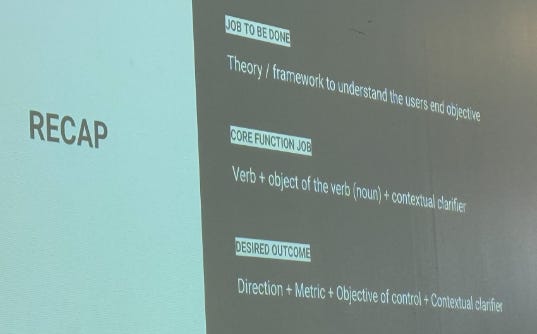Agile Manchester 2025: My Top Four Takeaways
Takeaways on quality, communication, and what great teams really focus on
In May I spent two days at Agile Manchester, catching up with old friends, hearing new voices, and making far too many notes. The conference was a brilliant mix of practical talks, thoughtful case studies, and big-picture keynotes.
As someone who thinks a lot about quality, collaboration, and how we work together, a few themes really stood out. Here are my top four talks, some reflections from the other sessions I joined, and what I’ll be taking back to my own work.
1. Understand the real user need
Nicola Dunlop’s walkthrough of Jobs To Be Done (JTBD) was one of the most thorough I've seen. It’s especially useful for Product people and UXers, but it also got me thinking about how JTBD could help QEs better understand the user's end goal, not just their tasks, but how they measure success.
If we’re serious about building in quality, we need to start with what our users are really trying to do, and how our product helps or hinders that. It’s a great way to explore what quality attributes actually matter and how we might measure whether we’re meeting them.
I tend to lean more towards Clayton Christensen’s take on JTBD (more high-level and theoretical) but this was a great reminder that frameworks are only useful if you use them.
Check out my notes to learn more about JTBD and how to use it to create better products: Jobs to Be Done: Turning Insights into Action
2. Perception is everything
Randy Silvers talk, The Secret Skillset of Successful Product People, really drove this home.
He reminded me that perception isn't just a “nice to have”, it's fundamental. The way people see your work (or your team, or your product) matters. And in software, where everything’s already a layer removed from the real world, those perceptions get even further from reality.
My big takeaway: Stories matter. They help people make sense of abstract work. They help align different mental models. And they’re often the difference between an idea landing or being left behind.
Take a look at my notes from Randy’s talk to learn more about how stories align perceptions and the three pillars of effective product organisations: The Secret Skillset of the Most Successful Product People.
3. Communication is a core engineering skill
Ceri Shaw’s talk Why Your Team Is Underperforming, really stuck with me. She made a strong case that poor communication is behind most underperforming teams. Yet we rarely train engineers in how to do it well.
It’s not just about clarity. It’s about knowing your audience, understanding how they process information, and tailoring your approach. That might sound obvious, but it’s often assumed rather than taught.
If we want more effective, aligned teams, we need to treat communication skills as essential for high-performing teams.
See my notes from Ceri’s talk to learn more about feedback, constructive conflict, and why your audience matters: Why Your Team Is Underperforming.
Don’t chase quality - build it in
I shared a framework for helping teams define what quality means to them and how they can embed it across their products, processes, and people.
Quality isn’t something we find at the end. It’s something we build from the beginning. And it’s easier to build when you’ve got a shared definition, a direction, and a few practical steps to get started.
I’ve written up the full talk and shared a facilitation guide to help you run a quality mapping session with your teams.
4. Uncertainty is part of the job. We've got to work with it
Ceri Newton-Sargunar closed the conference with a standout talk that mixed neuroscience, storytelling, and hope in the face of complexity. If you get a chance to see Ceri, you should.
Her core message was that in turbulent times, it’s easy to get stuck. But uncertainty doesn’t mean inaction. The trick is to stay grounded, pay attention to what’s working, and have the courage to try things no matter how small.
If we only focus on the bad stuff, we become attuned to seeing more of it. That doesn’t mean pretending everything’s fine. It means slowing down, zooming out, and remembering that even a lost beach ball can save a life (true story).
The talk really connected with my thinking on psychological safety and how uncertainty affects our teams. It’s not just about process, it’s about mindset, and how we respond to what we can’t control.
There were so many other takeaways from Ceri's talk, like how perceptions shape our reality, small actions matter, perspective taking is a tool, and we already have a lot of the tools we need to navigate uncertainty. See my notes for more: It's All Just as Bad as You Think It Is: A Message of Hope in Turbulent Times
Final thoughts
There were loads of other great sessions across the two days. From Kate Tarling’s opening keynote on service design to Dan Ashby’s take on living documentation in regulated industries.
But the big themes that stood out to me?
→ Know what your users really need
→ Pay attention to how your work is perceived
→ Treat communication as a first-class engineering skill
→ Build quality in from the start
→ And don’t wait for certainty - use what you’ve got
Check out my notes to dive even deeper and get my summaries, takeaways and images of slides.
Whether you're deep in quality engineering, building better products, or trying to support your team through uncertainty, I hope these takeaways give you something to reflect on.
I’d love to hear how these ideas land with you. Let me know via the comments.










